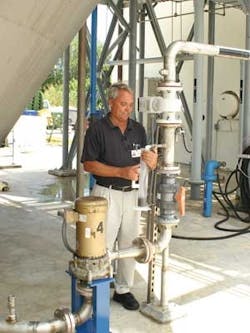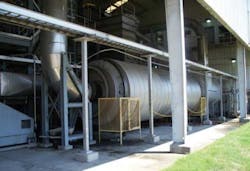Many treatment plant operators have learned firsthand that raw water drawn from deep reservoirs or lakes can acquire undesirable taste, odor and elevated manganese issues especially in autumn. Those conditions emerge with seasonal stratification and turnover that allow decaying plant and organic residue to reach the lower level "hypolimnion" and further deplete its already limited oxygen. The water quality changes can be measured in a lab or by the inevitable flood of customer complaints about the finished water reaching their taps, observed Sarah Dominick, PE, a water treatment engineer with Denver Water.
Established in 1918, the autonomous public agency serves more than 1.3 million people in the Mile High City and surrounding metropolitan area and enjoys an enviable reputation for producing the highest quality water. Even so, Denver Water shared the seasonal problems confronted by many utilities that use surface impoundments as their source for the raw water delivered to treatment plants. The problems were most pronounced at the 250 mgd Marston Water Treatment Plant, one of three drinking water treatment facilities in the utility's supply system.
Marston Reservoir, which serves as source water for the Marston plant, was built in 1899 on a site that absorbed two existing ponds. The maximum water level in the reservoir is 5538 feet above sea level and the utility rates the 621-acre reservoir's storage at 19,800 acre feet. Water drawn from a single outlet at a depth of 43 feet feeds into the neighboring treatment plant. The reservoir and plant complex became a cornerstone of the utility system's development to serve the population growth in the Denver area. As the service area and customer base increased, Denver Water has added the necessary assets and upgraded treatment to perform the mission.
A $2.6 million investment in 2009 put in place technology to eliminate the recurring seasonal changes. These occur during the turnover and settling of organic residues to the bottom of the storage pool and the reintroduction of metals and organic and inorganic compounds from the sediments that result from low dissolved oxygen in the hypolimnion.
Before the onset of reservoir stratification in June through the September turnover, an ECO2 "Speece Cone", submerged at the bottom of the 66-foot-deep reservoir, pumps oxygenated water into the 20- to 30-foot-thick hypolimnion zone. The system breathes new life into the anoxic layer of water as an alternative to the plant using chemicals, adding filtration or relying on earlier bypass infrastructure.
The installation was only the third of its kind at a terminal water reservoir and the technology was selected after various strategies and contracted consulting studies all indicated that oxygenation would be the most viable method to tame the seasonal issue affecting the reservoir.
"Paradoxically, the reservoir water quality had been very good by most standard measures," Dominick said. "However, the oxygenation system should further control the causes of seasonal complaints."
Bypassing the Problems
The utility had tried powdered activated carbon at the treatment plant but it proved expensive because of the plant's high flow rate. At first, instead of installing an in-lake treatment solution, Denver Water decided to simply work around the problem by building a bypass line in 1997 that allows water from the South Platte River to flow directly into the Marston Water Treatment Plant, thereby bypassing Marston Reservoir. The 108" dia. bypass line was significantly oversized to accommodate possible future plant expansions and offered an option whenever the water quality in the South Platte River was better than in the reservoir.
However, it was not the final solution, Dominick said.
Using water only from the bypass not only complicated the operation of the water system but an underlying risk also existed in depending on the bypass for the summer peak. The Platte River watershed upstream could be impacted by major forest fires, runoff from major storms and the inevitable drought conditions that could strangle water supply along the Front Range of the Rocky Mountains.
New System
At the recommendation of the Denver office of CDM (now CDM-Smith) and a California-based subconsultant, Alex Horne Associates, Denver Water invested in the Speece Cone, a submerged downflow contact oxygenation system.
ECO2 Technologies, Indianapolis, IN, collaborated with the utility staff and CDM in designing the system sized for maximum oxygen feed rate of 2,000 lbs/day. This design capacity should achieve and maintain a desired dissolved oxygen concentration in the lower levels of the reservoir based on the Hypolimnion Oxygen Demand (HOD) and Sediment Oxygen Demand (SOD). The engineering calculations reflected the volume of the hypolimnion (13 percent of the total pool) multiplied by the fairly constant average of dissolved oxygen in previous years.
"The SOD at the outset should decline soon to within the range of 500 to 750 lb/day. At that point oxygenation will then be needed only to balance the losses from Biochemical Oxygen Demand of algal decay after the built up SOD has been satisfied," Dominick said.
The 8-foot-diameter, 18-foot-high system presented an imposing apparatus during assembly onshore. Fabricated from stainless steel, the pump column side of the system houses a 35 hp Flygt submersible pump, supplied by Xylem (formerly ITT Water & Wastewater). Water Technology Group, a Xylem factory representative, supplied the Flygt pump. The only moving part of the entire system, the pump delivers a 3200 gpm flow at a head of 23 feet.
The unit was set from a barge on an elevated pad built up at the bottom of the reservoir in close proximity to the former ponds at the approximate center of the reservoir. Electricity and oxygen lines run approximately 2200 feet from an onshore service connection and liquid oxygen storage tank.
"When the Speece Cone is in operation, water from the bottom of the reservoir is pumped through the intake screen and pump column to the top of the cone where the gaseous oxygen is being simultaneously fed into the cone. The pump force pushes the super oxygenated water into a 40-foot-long linear diffuser whose ports deliver it in a horizontal discharge," Dominick said.
As the water travels down through the cone it dissolves the oxygen. In theory, 100 percent efficient oxygen transfer is possible which would result in no bubbles leaving the cone. However, 90- to 95-percent efficiency is more common, Dominick said.
Much of the system was inspired by an earlier Speece Cone installation in California. The method for infusing supplemental dissolved oxygen into the reservoir's anoxic "dead zone" offered a number of benefits, said Kelly DiNatale, PE, who led the project while at CDM and is now head of DiNatale Water Consultants. He notes that the typical candidate for a Speece Cone depends on the hypolimnion. These are typically lakes and reservoirs that stratify and have a minimum 50 foot depth with a hypolimnion of at least 20 feet.
"In general, the Speece Cone has the advantage of allowing the use of pure oxygen," DiNatale said. "Conventional compressors are pumping air that has an oxygen content of approximately 21%, meaning that nearly five times the volume of air must be pumped compared to delivering pure oxygen. The relatively low efficiency of the air compressor for a conventional aeration system becomes an important consideration when evaluating life cycle operations and maintenance costs. In the Marston installation, the system uses only a 35-horsepower Flygt pump to achieve an extremely high percentage of efficiency in oxygen transfer. You move five times the volume of oxygen compared to a conventional aeration system."
The diffused, sidestream delivery of the oxygenated water occurs at 6 feet above the sediment bed. This minimizes turbulence, suppresses nutrient releases and maintains stratification of the reservoir while producing a high level of dissolved oxygen directly above the sediment, DiNatale said. The system does not destratify the lake, thus minimizing the mixing of any algae from the surface and maintaining a desirable cool temperature in the hypolimnion.
Unseen Site Conditions
Although the reservoir is shallower that many stratified lakes, the 66 foot depth for the oxygenation system was particularly challenging because the reservoir's topography presented two depressions at the site of the earlier ponds. These were much deeper than the Marston Reservoir's outlet located at the dam. Most lakes are typically deepest off the face of the dam but not in this case.
"More than six feet of sediment had accumulated since the reservoir was built more than century earlier," Dominick said.
Working from the barge, RN Civil Engineering Construction, officed in Englewood, and subcontractor Northwest Underwater Construction, officed in Vancouver, Washington, removed the muck with a vortex pump and deposited it at another location in the lake. This prepared firmer ground for the elevated bed of rip rap and aggregate that received the concrete pad for the Speece Cone and its diffuser.
"The muck on the bottom was so deep that a diver had to probe it with a length of rebar to establish the parameters for the base of the pad," Dominick said. "Those ground conditions made the work significantly more expensive than what we expected."
Initial Results
The system began initial operation at 100 percent output (approximately 2000 lbs/day) in mid-May, 2009. That represented a delivered cost of $92 /day in liquid oxygen. At that amount, the oxygenation reversed the Dissolved Oxygen (DO) depletion and increased the level at the bottom of the reservoir to a pre-stratification level of 10 mg/l.
After four weeks of operation the system feed rate was reduced to 75 percent output, or 1500 lbs/day which reduced the expense to $69/day. DO levels remained high, with a concentration in the hypolimnion of 10 mg/l on July 1 compared to normal early July concentrations of 2 mg/l. A week later the feed rate was reduced to 50 percent that brought a steady decrease in the bottom DO. The feed rate was then increased to 75 percent when the DO dropped to 8 mg/l which slowed the decline. The oxygenation rate was then increased back up to 100 percent completely reversing the decline in DO. Therefore, it appears an oxygen feed rate of 75 percent to 100 percent may be necessary for the first few years to maintain the utility's minimum bottom DO level above 5 mg/l.
The utility has been pleased with the results over the first few years and can now address the long deferred construction of a new outlet to the plant.
"With the recent oxygenation system added to the reservoir, we have moved ahead with the design of a new multi-level intake that is now in the permitting stage," Dominick said. "It is designed as an intake tower with three different elevations, one low, one at medium level and the third higher up. The lowest is actually a little below our original one at 43 feet."
More WaterWorld Current Issue Articles
More WaterWorld Archives Issue Articles





